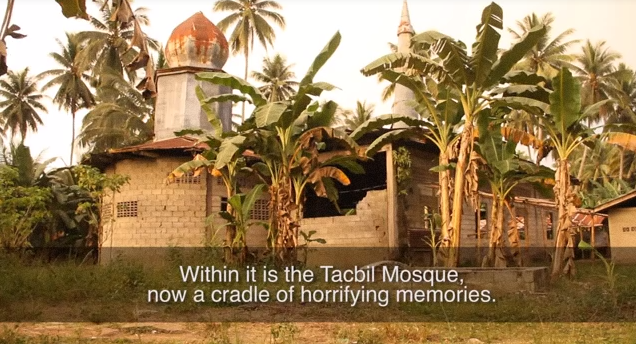Date first published: September 24, 2017
This article was first posted four years ago. We are reposting this on the front page to pay tribute to the victims of the unimaginable atrocity. This should not happen again.

President Rodrigo Duterte likes to cite history when he talks about Mindanao. He would launch into a tirade against the U.S. for the historical injustices it has done to the Bangsamoro people.
The first Mindanaoan president, however, never mentions another period of the region’s history marred by human rights abuses: that under the late dictator Ferdinand Marcos, whose remains upon Duterte’s approval were transferred at the Libingan ng mga Bayani in a clandestine burial last year.
One such unfortunate event happened exactly 43 years ago today: The Malisbong Massacre, also called the Palimbang Massacre.
Several studies, media reports and testimonies of survivors themselves identified the military forces during Marcos’ martial rule as the one behind the killings.
The report by the Transitional Justice and Reconciliation Commission (TJRC) said about 1,500 Moro men and women were killed by military and paramilitary forces in September 1974 at the coastal community of Malisbong in Palimbang, Sultan Kudarat.
The TJRC is an independent body tasked by the government and the Moro Islamic Liberation Front (MILF) peace panels to conduct a study and make recommendations to address human rights violations, correct historical injustice and promote healing and reconciliation among communities affected by the conflict in the Bangsamoro region.
A massacre survivor told the commission that more than 1,000 people were locked up inside a mosque and never seen again.
“Every day in the mosque, the Army would get one to 10 persons. Those who were inside the mosque would hear shots of fire hours after these people were taken outside. And those who were taken outside never came back,” the TJRC report quoted the survivor as saying.
The survivor said his grandfather was buried alive while another relative was nailed to a cross like Christ.
His father, brother and other relatives were taken outside and first stripped of their clothes.
“They were brought to the beach; they were made to dig their own graves; and when they were done, they were shot and killed,” the survivor said.
The same harrowing testimonies were recounted by other survivors in a documentary produced by the Commission on Human Rights (CHR).
Abdulsukor Tacbil, who was only 11 then, said women and children were separated from men. The men were ordered to go inside the mosque while women and children were made to board a naval vessel anchored offshore.
“Isang araw doon nabilad kami, gutom, yung iba dyan nakita ng mata ko, meron ding namatay na kuan sa laki ng naval. Ang iba itanapon na mga bata kasi nagsakit sa init ng araw (One day we were exposed to the sun, we were starving, I saw people dying. The children who got sick from too much exposure from the sun were thrown off the sea),” said Tacbil.
There were also accounts of women being raped and killed by the military.
In September 2014, 40 years after the gruesome incident, the CHR acknowledged the atrocities that happened in Malisbong. Survivors and families of victims were included among the claimants of the P10 billion fund set aside by the government to compensate human rights victims during martial law. (See VERA FILES FACT SHEET: The sins of martial law, in tranches)
The TJRC documented other cases of human rights abuses in Mindanao during Marcos’ martial law through witness testimonies. They include the “Tran Incident” and the “Tong Umapuy Massacre.”
The Tran incident refers to a military campaign against the Moro National Liberation Front (MNLF) in Central Mindanao from June to August 1973. Moro civilians from Populacion in Kalamansig, Sultan Kudarat were confined in a military camp, interrogated and tortured. The women were taken aboard the naval vessels and raped.
The Tong Umapoy Massacre happened in Tawi-Tawi in 1983, wherein a Navy ship allegedly opened fire on a passenger boat and killed 57 people on board. The passengers, according to testimonies, were on their way to an athletic event in the capital Bongao.
Atrocities committed by state-affiliated armed groups such as the Ilaga during martial law are also highlighted in TJRC’s report and considered as “one of the most disturbing human rights legacies of the 40-year-old conflict.”
The TJRC report and several other research works said the presence of Ilaga in the region resulted in the land dispossession and displacement of the Moros and indigenous peoples there.
Even before martial law was declared, the Ilaga group already started its violent activities.
Accounts from the TJRC report and a study by the World Bank believe the Ilaga has ties with state authorities, including local and national politicians, in order to suppress the growing armed Moro movement.
The late president Diosdado Macapagal also acknowledged this link.
In a book titled Bangsamoro: A Nation Under Endless Tyranny, Macapagal was quoted saying: “The policy and short-sighted handling of Muslim problems under the Marcos reign reached a zenith when the authorities sanctioned and believably helped arm the Ilagas, an armed band of Christian Filipinos, who have waged an operation to kill Muslims.”
Macapagal lost to Marcos in the 1965 elections.
Besides indiscriminate killings and burning of houses, the Ilaga, according the the TJRC report, used specific signatures in committing crimes: mutilation and desecration of bodies, including acts of cannibalism.
Being the bearer of honor and culture, women and girls were not spared and were used by Ilaga members and soldiers to destroy the moral fabric of the Moros.
The TJRC reported accounts of women being raped by the Ilagas and soldiers in front of their families or of women forced to have sex with their husbands for the amusement of soldiers.
Between 1972 and 1974, women were forced to work as sex slaves for navy men. The report added: “For more than a week, soldiers rounded up a group of at least 10 women from Labangan and forced them to the naval boats to serve the sexual needs of the navy men. The following day they were released only to be replaced with another group of women.”
Many Moro women and young girls who were abducted and raped were never seen again.
Sources:
Report of the Transitional Justice and Reconciliation Commission
Transitional Justice and Reconciliation Commission, The Listening Process Report 2017
Jubair, S. (1999). Bangsamoro: A Nation Under Endless Tyranny, 3rd ed. Kuala Lumpur: IQ Marin.
Land: Territory, Domain, and Identity
Media interview with President Rodrigo Duterte, Lima, Peru, November 18, 206
1,500 Moro massacre victims during Martial Law honored
— Daniel Abunales
(Guided by the code of principles of the International Fact-Checking Network at Poynter, VERA Files tracks the false claims, flip-flops, misleading statements of public officials and figures, and debunks them with factual evidence. Find out more about this initiative.)




